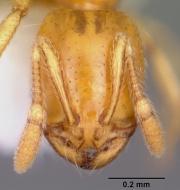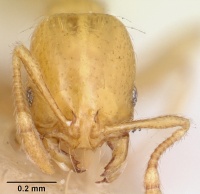Solenopsis globularia species complex
The following is based on: Pacheco, J.A. & Mackay, W.P. 2013. The systematics and biology of the New World thief ants of the genus Solenopsis (Hymenoptera: Formicidae). Edwin Mellen Press, Lewiston, New York. 501 pp. PDF
Solenopsis globularia Species Complex
This is a group of New World thief ants in the genus Solenopsis.
Diagnosis - The workers of this complex can be distinguished by their greatly dilated, globose postpetiole. Additionally, the clypeal carinae are well developed with five teeth present on the anterior clypeal margin. The extralateral teeth are present as angles, the lateral teeth are well developed and a medial tooth is present as well. Moreover, the workers of this complex have horizontal striae present on the mesopleuron as well as the metapleuron and range in color from pale yellow to dark brown. The eyes are large, with 12-25 ommatidia. Solenopsis globularia is polymorphic, while S. bucki, S. desecheoensis and S. lucayensis are monomorphic, based on examined material.
All members of this species complex are highly variable. The eye can have 12-25 ommatidia, the medial clypeal tooth can be viewed as well developed to nearly absent, striae is present on the mesopleuron and covers the whole propodeum. Because of these variable characters, we propose synonymy of all varieties and subspecies as the polytypic Solenopsis globularia. The only species that does not have striae covering the whole propodeum is S. lucayensis and it is concolorous pale yellow, monomorphic and based upon available all workers appear to have 12-15 ommatidia and we raise it to species status. The variety from Desecheo Island is concolorous dark brown and appears to be monomorphic is given new status, as a valid species. Solenopsis bucki is undeniably a member of this species complex based on the large eye (20 ommatidia), striated mesopleuron and metapleuron and globose postpetiole. The globose postpetiole is the definitive trait of these species, but is also found in a potentially unrelated species (a possible parallelism), S. loretana (placed in the molesta species complex). Solenopsis loretana can be separated based on the much smaller eye that only contains five ommatidia and is only mentioned to reduce confusion in identification.
You might also be interested in
Key to workers of the globularia species complex
1
- Mandibles straight, narrow, with 2 teeth on the masticatory margin; workers without medial tooth on clypeal margin and without horizontal striae on mesopleuron; southern Brazil . . . . . Solenopsis bucki
- Mandibles slightly curved and relatively wide, with 4 teeth on the masticatory margin; workers typically with medial clypeal tooth, mesopleuron horizontally striated . . . . . 2
2
return to couplet #1
- Workers polymorphic; usually bicolored (head and mesosoma yellowish-brown, gaster darker brown); eye with 15-25 ommatidia; head width 0.45-0.52 mm; length of minor funicular segments (3-8) 0.162-0.210 mm; widely distributed USA to Paraguay and southern Brazil . . . . . Solenopsis globularia
- Workers monomorphic; concolorous yellow or concolorous dark brown; eye with 12-25 ommatidia; head width 0.42-0.48; length of minor funicular segments (3-8) 0.162-0.180 mm; Caribbean . . . . . 3
3
return to couplet #2
- Eye with 12-15 ommatidia; concolorous pale yellow; striae lacking on dorsum of propodeum; Bahamas, Andros Island . . . . . Solenopsis lucayensis
- Eye with approximately 25 ommatidia; concolorous dark brown; striae present on dorsum of propodeum; Desecheo Island near Puerto Rico . . . . . Solenopsis desecheoensis
Clave para las obreras del complejo globularia
1E
- Mandíbulas rectas, estrechas, con 2 dientes en el margen masticatorio; obreras carecen de diente medial en el margen clipeal; sin estrías horizontales en la mesopleuron; sur de Brasil . . . . . Solenopsis bucki
- Mandíbulas débilmente curvadas y relativamente anchas, con 4 dientes en el margen masticatorio; obreras típicamente con el diente clipeal medial, mesopleuron con estrías horizontes (Fig. 99) . . . . . 2E
2E
return to couplet #1E
- Obreras polimórficas; generalmente bicoloreadas (cabeza y mesosoma de color marrón amarillento, gáster marrón más oscuro); ojo con 15-25 omatidios; ancho de la cabeza 0,45-0,52 mm; longitud de los segmentos funiculares menores (3-8) 0,162-0,210 mm; distribuido extensamente; EUA hasta sur de Brasil . . . . . Solenopsis globularia
- Obreras monomórficas; marrón oscuro o todo amarillo; ojo con 12-25 omatidios; ancho de la cabeza 0,42-0,48; longitud de los segmentos funiculares menores (3-8) 0,162-0,180 mm; Caribe . . . . . 3E
3E
return to couplet #2E
- Ojo con 12-15 omatidios; todo amarillo claro; carecen de estrías en el dorso del propodeo; Bahamas, Isla de Andros . . . . . Solenopsis lucayensis
- Ojo con aproximadamente 25 omatidios; todo marrón oscuro; estrías presentes en el dorso del propodeo; Isla de Desecheo cerca de Puerto Rico . . . . . Solenopsis desecheoensis



